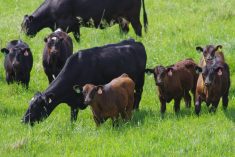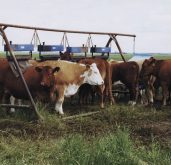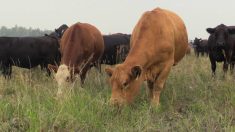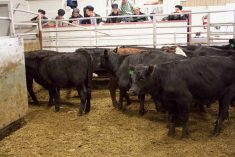Manitoba Agriculture Minister Ron Kostyshyn says there will be no Crown land auctions this month.
The province has paused lease allocations while it takes another look at the agricultural Crown land program, he announced Jan. 29.
“We’ve paused it for a number of reasons. Actually, we feel that we need to maybe do some consultation and basically do a review of the Crown land program.”
Read Also

Journal pulls long-cited glyphosate study for ethics violations
The journal Regulatory Toxicology and Pharmacology has retracted a 2000 Monsanto-linked glyphosate review, drawing new scrutiny as Bayer faces mounting legal pressure.
Why it matters: Ranchers spent years criticizing the former government’s Crown land regulation overhaul, and changes were part of the NDP’s election campaign last fall.
The last five years of system changes will be going under the microscope, Kostyshyn said. The province will also help existing leaseholders adjust to regulation changes that came into effect at the start of 2024.
Ultimately, the department hopes to “determine the future of program priorities.”
“It’s always healthy to review policies that have come into play,” he said. “Has it accommodated the wishes of the organization? The cattle industry? The Manitoba Beef Producers?”
The controversy
If that question was posed to ranchers, the answer would likely be no.
Changes to the Crown land system, starting in 2018, sparked considerable outrage in the Parkland and Interlake – areas where leased land often accounts for large chunks of farm land bases.
The Crown land modernization, ushered in by the then-governing Progressive Conservatives, first did away with the old points system, which weighted a producer’s lease application based on factors like age or proximity to the parcel. An auction system was put in its place.
That was fine with much of the beef sector, which had complained that the points system was difficult to understand, and it wasn’t always clear why a parcel went to a certain applicant. At the same time, some ranchers raised concern that auctions would disadvantage young farmers, since they had little hope of outbidding an older, larger farm.
Things came to a head the following year. Leaseholders had been in limbo as the province worked on new regulations to go with the new allocation system. Within days of those rules announced in fall 2019, producer anger was in full flame.
The new regulations limited leases from 50 years to 15, which ranchers said removed business continuity and made it difficult to make long-term business plans.
The province later added a first right of renewal for existing leaseholders because of the backlash.
Other issues included a new market-based rental formula that increased costs, less recourse for land improvement valuation and the elimination of unit transfers that allowed producers to transfer leased land rights along with the sale of private land.
The unit transfer became a particular sticking point. Ranchers said it was key to retirement plans and that, if the majority of a ranch’s land base was tied up in Crown lands, farms were unsellable without it.
At the height of the conflict, the Manitoba Crown Land Leaseholders Association began preparations for a legal challenge.
In 2023, after then-ag minister Derek Johnson reopened the file, the province announced new rules. These are the rules referenced by Kostyshyn, which came into play at the start of this year.
Those changes allowed a leaseholder to transfer the remainder of their lease and allowed legacy leaseholders to nominate the next leaseholder, “subject to the Treaty Land Entitlement and consultation assessment.”
Outgoing leaseholders could be compensated for land improvements based on an appraisal, and producers with a forage management plan could extend their term for five years.
The PC’s had also announced graduated rent relief (50 per cent below the formula in 2023, with the reduction shrinking to 33 per cent in 2024 and 15 per cent in 2025), due to several years of poor forage harvests. The NDP extended that relief to a 55 per cent reduction for 2024.
Crown lands changes featured in the NDPs platform during the 2023 election, and Kostyshyn’s mandate letter later, called for him to reinstate unit transfers.
Nuts and bolts
Kostyshyn has previously said the government will start “from ground zero” on the file. That will start with in-house discussions on Crown land changes and their impacts, after which Kostyshyn said producers can expect consultations.
“We want to do it right,” he said. “We want to do it properly, and that’s why we’re going to pledge to have the blueprint redesigned and hopefully meet with producers or meet with organizations, but we have to do it in-house first and foremost.”
The pause will not impact shorter-term one-year agreements, Kostyshyn said. He added that the door is open to make vacant Crown land available for grazing in 2024, as has been previously done in poor hay years.
That’s good news for Brent Benson, president of the Manitoba Crown Land Leaseholders Association and a producer near Winnipegosis. Current moisture conditions indicate a coming dry year and Benson noted sparse snowpack and concern over dugout recharge.
Farmer reaction
He said the auction pause is prudent if the system is about to go under review.
“It’s probably a good idea to hold off allocating another (round) this year under the old rules if they’re going to change the rules anyway in a couple of months.”
He added that the association is optimistic about the province’s trajectory. There has been cumulative damage from the last five to six years of prolonged uncertainty, he said. Trust in the system, and therefore ability to plan within the system, has been rocked.
Few farms have been taken over since the modernization rules came down, Benson noted.
“It’s going to cause a pretty bad name for the province here in terms of attracting new producers. We’re just not getting the kids coming up to take over a generational farm.”
Lease renewability tops his group’s wish list going into the review, Benson also said, calling it “huge” for attracting and keeping families in the region.
Timeline
Kostyshyn did not provide a timeline for the review. Benson hopes to see changed rules by the end of the year because that would see a new system in place for 2025 allocations.
Ranchers have been living with uncertainty for so long, “they’re almost getting numb to it,” he said. “But if we could find some hope that by the end of summer here, they could have rules in place and people could know for Jan. 1 that this will be the way moving forward that things will be happening, it would (bring) a lot of relief.”
It would also allow people to move ahead with retirement.
















